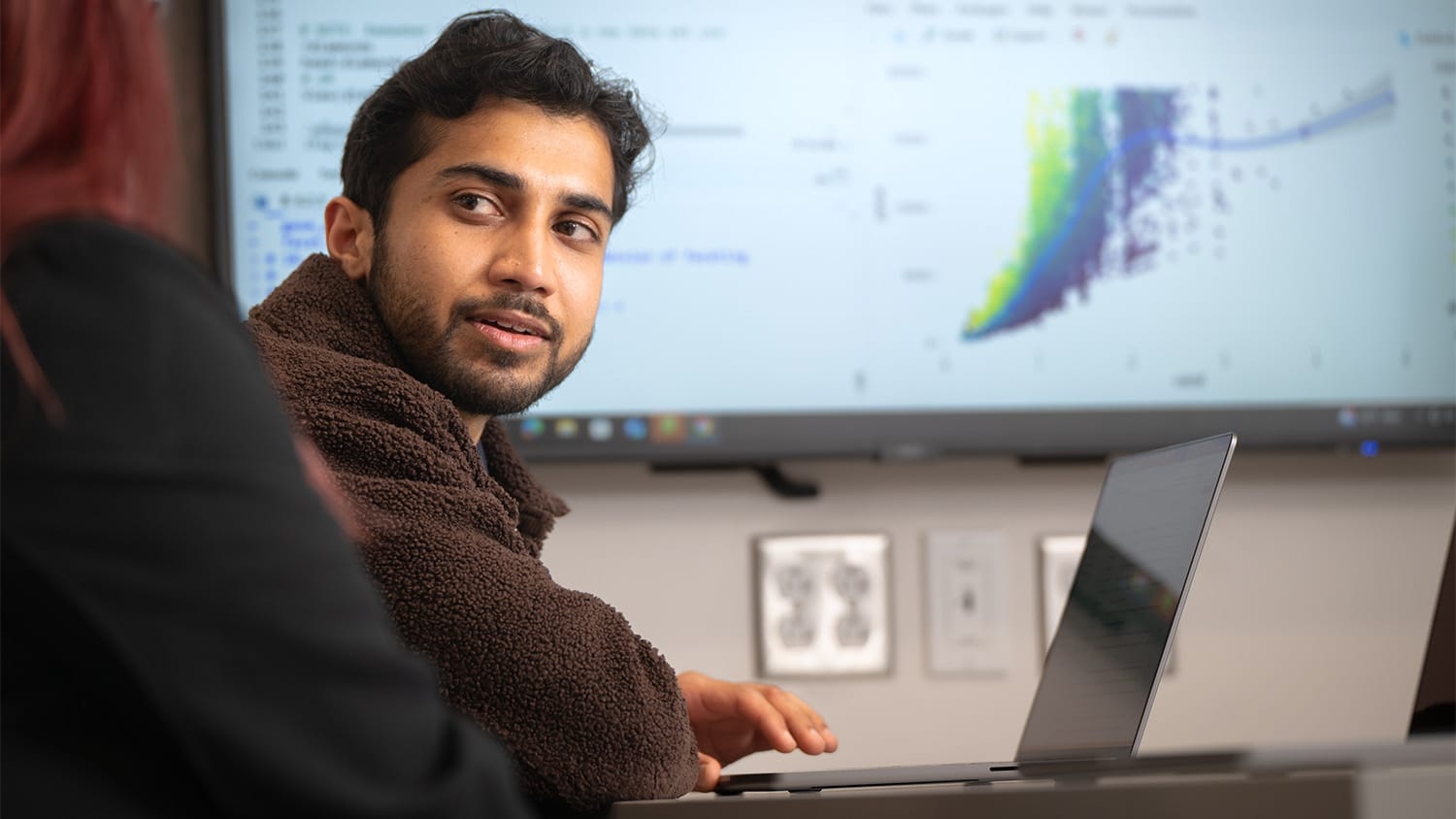Trusting Their Gut: NC State Spinout Company Knows Cows Hold the Key to Quickly Cooling the Climate
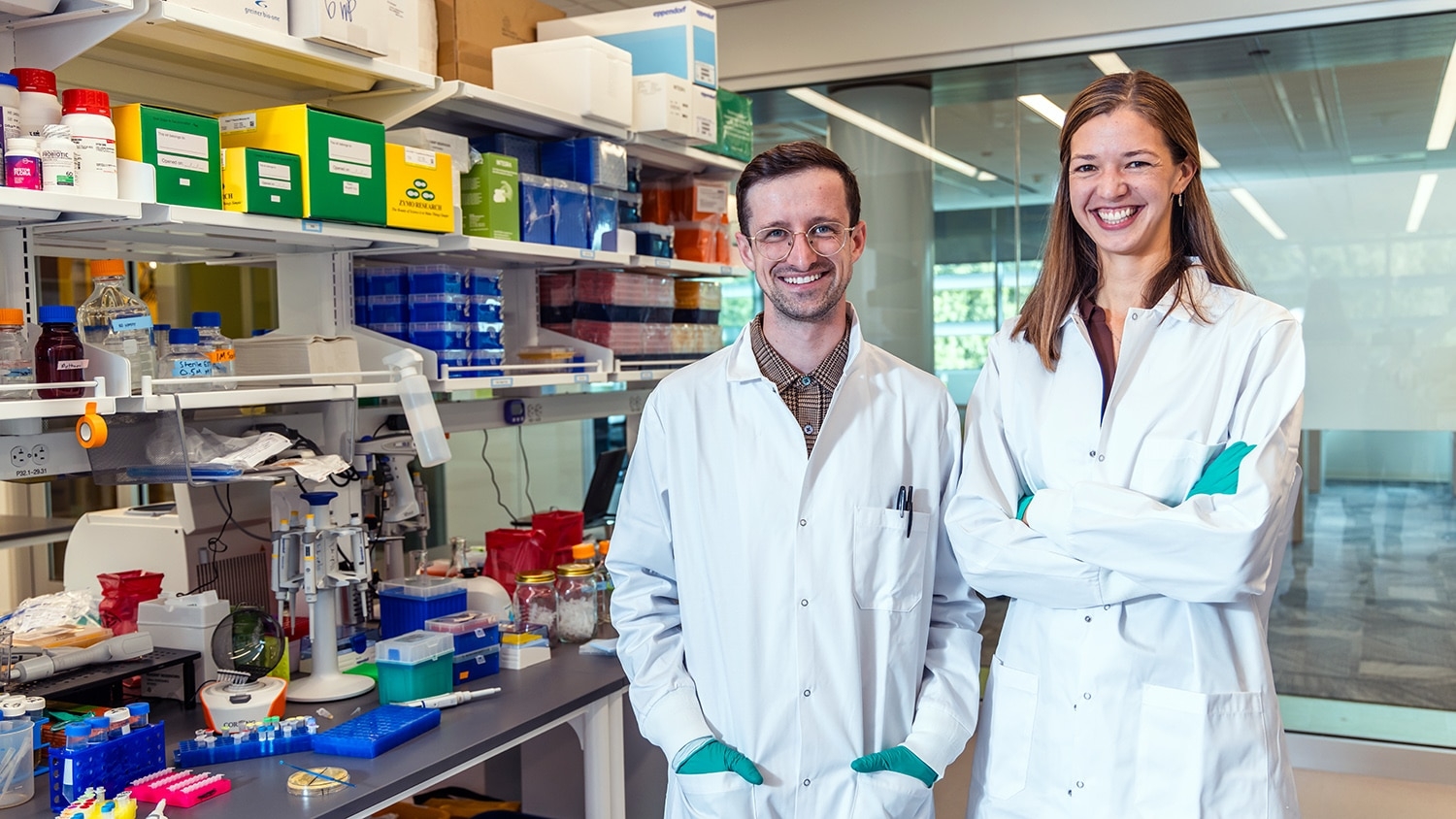
For almost as long as NC State University has existed, sports rivals have teasingly called us Moo U or Cow College, thanks to our strengths in agricultural research and education.
So it’s only right that decades of groundwork at NC State might one day help cattle farmers worldwide better control their livestock’s gut microbiome — a collection of microbes that aid digestion — and cool the climate as a result.
Cows pass a lot of gas. And the methane that gas puts out has been proven as one of the main drivers behind climate change. The average cow belches around 220 pounds of methane a year — helping make cattle the largest agricultural source of greenhouse gasses across the globe.
“About 30% percent of current warming is from methane,” says Scott Collins, co-founder and chief scientific officer of a startup called Hoofprint Biome, who holds a Ph.D. from NC State in chemical and biomolecular engineering.
Hoofprint — a biotech company Collins and fellow alum Kathryn Polkoff launched this year, which is licensing NC State research-based patents through the university — has discovered novel enzymes that could naturally prevent methane production in cattle.
Others have tried to reduce methane emissions from cattle in the past, with varying degrees of success. But what sets Hoofprint’s proposed approach apart from all others is that it seeks to improve cattle’s health at the same time.
“Methane production comes at a cost to the cows,” says Hoofprint co-founder and CEO Kathryn Polkoff, who holds a Ph.D. from NC State’s top-ranked College of Veterinary Medicine. “In fact, it takes up to 10% of the cow’s energy.”
Hoofprint plans to use a yeast probiotic to transport its special enzymes to cows’ stomachs, where it will then release the enzymes and provide other potential perks. The startup wants its enzyme-infused probiotic to not only eliminate methane but also further aid animal health and nutrition.
Collins says 75% of cows’ energy comes from their microbiome.
“As humans, we think of gut microbes as just a part of being healthy. But for cattle, they’re completely reliant on their microbiome,” Collins says. “So for us, it’s the most obvious place to deploy probiotics — it’s going to have the largest impact.”
Polkoff and Collins founded Hoofprint in the spring, and the nascent company currently calls the NC State Plant Sciences Building home.
“We felt like NC State was the perfect place to do this,” Collins says. “How many places in the world could you start this company?”
As part of a $4.25M pre-seed funding round, Hoofprint received $2.5 million in August from a New Zealand-based investment fund named AgriZero — which, according to its website, aims to “reduce agricultural emissions by 30% by 2030.” AgriZero was joined in this pre-seed round by Ponderosa Ventures, Good Growth Capital and the Twynam Earth Fund.
Polkoff knows the enzymes Hoofprint has discovered represent a “huge opportunity” to “drastically minimize the impact” that beef and dairy consumption has on the climate. She and Collins realize, though, that the solution they propose must also make sense for farmers.
To be successful, Polkoff says they need to eliminate methane from cows while simultaneously offering advantages to the people who rear them.
That’s largely the reason why they’ve chosen a certain type of yeast — Saccharomyces boulardii — to carry their methane-preventing enzymes. Saccharomyces boulardii’s probiotic effects have been scientifically proven to increase feed efficiency in cattle.
“If we give farmers a way to help their business at the same time, they can be a critical part of both feeding the world and helping stave off climate change,” Collins says.
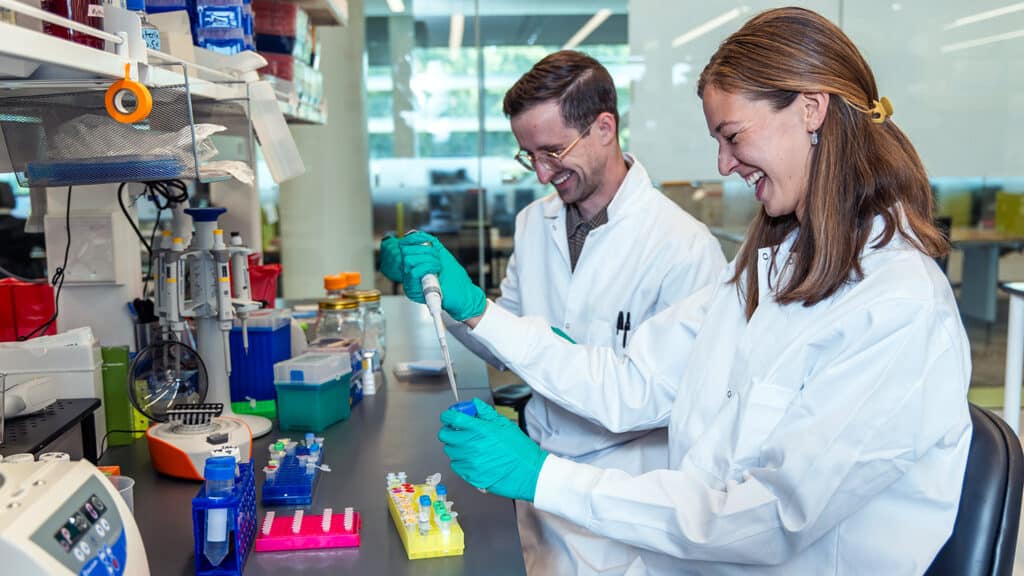
How Hoofprint Got Here
Like many Ph.D. students, Polkoff envisioned a career in academia after graduation. She knew she wanted to stick with translational research and remain “close to the clinic or close to the field.” But Polkoff says she never considered starting a business until being introduced to Collins, who “didn’t take no for an answer.”
“I convinced her to abandon her dream of being a professor and start a company with me instead,” Collins says.
Collins had been looking for a co-founder for some time when he and Polkoff were connected by Kultaran Chohan, executive director of NC State’s Office of Research Commercialization (ORC).
Chohan knew both of them through the Chancellor’s Innovation Fund (CIF), a competitive seed funding program ORC manages. The university established the CIF to help commercially focused research bridge the gap from public to private funding — and, if successful, one day become a product, technology or another form of intellectual property with tangible benefits to society.
“Realistically, we wouldn’t be here if it wasn’t for the CIF,” Polkoff says.
Polkoff worked on a CIF project in 2019 during her Ph.D. with her advisor, Jorge Piedrathita, the Randall B. Terry Jr. Distinguished Professor of Translational Medicine and director of the Comparative Medicine Institute. And Collins worked on a CIF project in 2021 as a postdoctoral researcher with his former co-advisor Chase Beisel, who was an associate professor in the Department of Chemical and Biomolecular Engineering and now works at the Helmholtz Institute for RNA-Based Infection Research, in Germany.
Based on similarities between their CIF research projects, Chohan had a hunch that Collins and Polkoff would make a good team.
He was right.
And ever since Collins and Polkoff’s partnership reached the point where they were ready to start a company, ORC has been there to assist every step of the way. Polkoff says that Chohan played a crucial role in helping the pair secure their first patent early on, for example.
However, Polkoff and Collins also say they owe significant thanks to two faculty members who’ve mentored them from day one — and have been researching related topics since well before their startup was born.
Cows are one of many mammals known as ruminants. That means, among other things, they depend on microbes in their rumen — the largest of their four stomach chambers — to digest grass and other feed.
Vivek Fellner, a professor in the Department of Animal Science, has been studying ruminant nutrition for over 40 years.
“We’re so lucky to have him nearby,” Collins says.
When they first started Hoofprint, Collins says he and Polkoff asked Fellner to tell them “everything everyone has ever done and tried that didn’t work.”
“I think that’s a very important consideration,” Fellner says. “Not everyone is willing to look behind in order to move ahead.”
“They’re enthusiastic, and they’re clearly competent and capable of making some substantive progress in this area,” Fellner says. “So I believe strongly in what they are planning to do — and what they might achieve.”
Collins also credits his former Ph.D. co-advisor Nathan Crook, an assistant professor in the Department of Chemical and Biomolecular Engineering, with pioneering “a lot of the early techniques” for how to use Saccharomyces boulardii — which has long been used to treat and prevent diarrhea in humans — as a way to “deliver therapeutic proteins.”
Hoofprint is licensing Crook’s patented techniques to help create what the company is calling an “engineered probiotic,” which will deliver its methane-preventing enzymes along with other benefits once it reaches the cow’s rumen.
Collins worked as a researcher in Crook’s lab for several years throughout and after his doctorate; his time there helped Collins see the potential Saccharomyces boulardii might hold for cattle farmers.
“Scott was really clever and realized that boulardii is also used in agriculture and animal agriculture, as a general-purpose growth promoter,” Crook says. “And he was very passionate about methane sequestration.”
“Hoofprint’s goal is to engineer this particular yeast to secrete an enzyme that can reduce methane emissions from cattle. Because this yeast can actually get into the rumen of the cattle and live there,” Crook says.
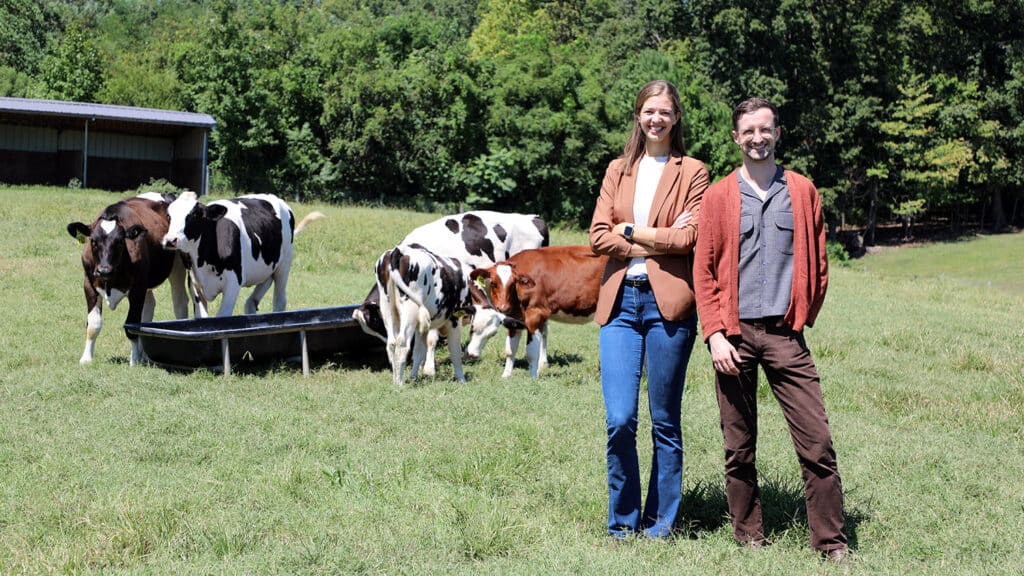
Where They Are Now
In addition to the multimillion-dollar venture capital deals they recently struck, Collins and Polkoff were named to the latest cohort of Breakthrough Energy Fellows, as “Innovator Fellows” — which the Fellows program’s website defines as “world-leading scientists and engineers who enter the program with a critical climate technology to commercialize.”
Founded by Bill Gates to support “the best early-stage clean-tech innovations,” the Fellows program is “designed to ensure early-stage entrepreneurs working on groundbreaking scientific solutions have the R&D funding, educational resources, and network they need to realize the full potential of their technology,” according to the program’s website.
“I’m most excited about the opportunity to make technical progress during the program and then share perspectives and insights with the [agricultural] community,” Polkoff said in a news release from the Fellows program. “These farmers are the ones tackling the toughest challenges humanity has ever faced.”
Since Hoofprint was founded, Polkoff says their primary focus has been on “building the technology around the problem.”
“What tools do we need to license? What tools do we need to build? That’s what we’ve been doing,” Polkoff says.
And Polkoff and Collins consider themselves fortunate to be somewhere it’s so easy to soak up the collective creativity of collaborators and others nearby with similar skills or complementary capabilities and knowledge.
“You walk around campus and you just have so many brilliant people with so many amazing, different areas of expertise,” Polkoff says.
“We get to work in this beautiful building, where there are a lot of others working in parallel tracks or in similar spaces. So it’s been fun to collaborate and get to know people in the building who understand the same kinds of problems we’re working on. We’re really lucky to be here.”
That’s why, for the near term, Hoofprint intends to stay rooted in the Plant Sciences Building — a $160M research and innovation facility positioned in the heart of Centennial Campus, which aims to make North Carolina a global hub for plant sciences.
The Plant Sciences Building serves as a state-of-the-art headquarters for the N.C. Plant Sciences Initiative.
Representing the latest thinking in design and construction to meet the complex needs of team-based plant science, the unique building — which contains 185,000 square feet of greenhouse, lab and office space for faculty, students and partners — provides maximum potential for collaboration, interdisciplinary activities and innovation.
Hoofprint is one of the inaugural tenants in the building’s incubator space for startup companies.
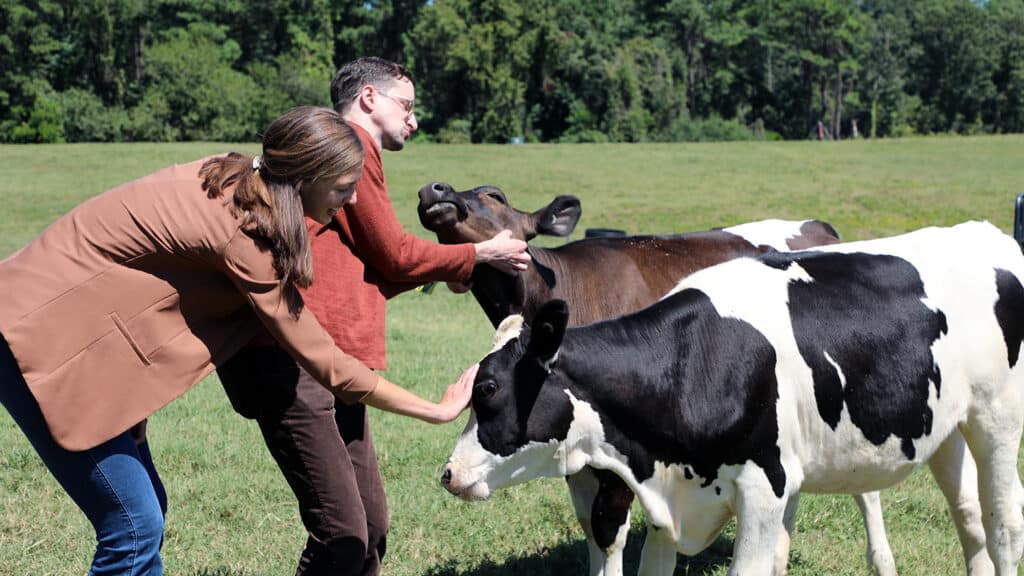
What’s Ahead
The company will continue to work closely with the Fellner lab and the Office of Research Commercialization, as well as other groups at the university.
“I’m set up to do a lot of in vitro and in vivo testing on feed additives, and their plan fits right into my regular program here, where we look at how we can manipulate microbes,” Fellner says. “We can do a lot of screening, in several ways, looking at different additives and how they might work in the gut.”
With all the work they have ahead of them, Hoofprint will be looking to hire more help. Thanks to the significant financial support they’ve secured, Collins and Polkoff expect to double the size of their four-person team by sometime next year.
But Collins says they still like to spend as much time in the lab or field themselves as time allows — and certainly don’t mind doing the dirty work.
His CEO “will still put her arm in a cow” whenever needed, Collins says.
Polkoff and Collins plan to put most of their current capital toward initial in vivo trials. They’re currently testing the efficacy of their probiotic using stomach fluid samples from the Fellner lab’s cows.
“We can culture samples in the lab, and that allows us to do some in vitro testing without having to shovel poop or milk the animal — which makes it a little more convenient,” Fellner says.
Likewise, Hoofprint knows the product it ultimately brings to market needs to be as convenient as possible for cattle farmers.
The company wants it probiotic to be “easy to deploy” — not a “fancy medicine” — Collins says. If everything goes according to plan, farmers will be able to simply mix dried yeast into the feed — and cows won’t taste the difference.
“It’s kind of crazy to say out loud, but we want to have a product that’s fed to every cow in the world,” Polkoff says.
Years of sweat equity and many hurdles lie ahead before their lofty goals can reach reality — but Collins knows that Hoofprint’s mission to reduce methane emissions is the fastest way we can stem the tide of climate change.
“The beauty of eliminating methane is that it actually can help cool the climate within 10 years,” Collins says.
“Methane breaks down over 10 years,” Collins says. “If we eliminate those methane emissions, the climate actually cools. It is the most impactful thing we can do in the short term.”
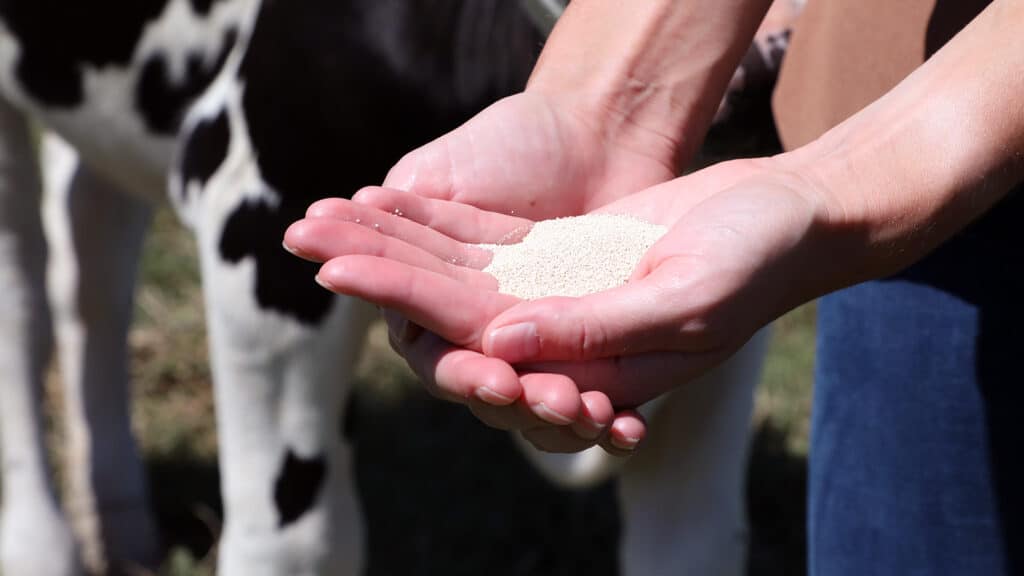
This post was originally published in NC State News.
- Categories:

